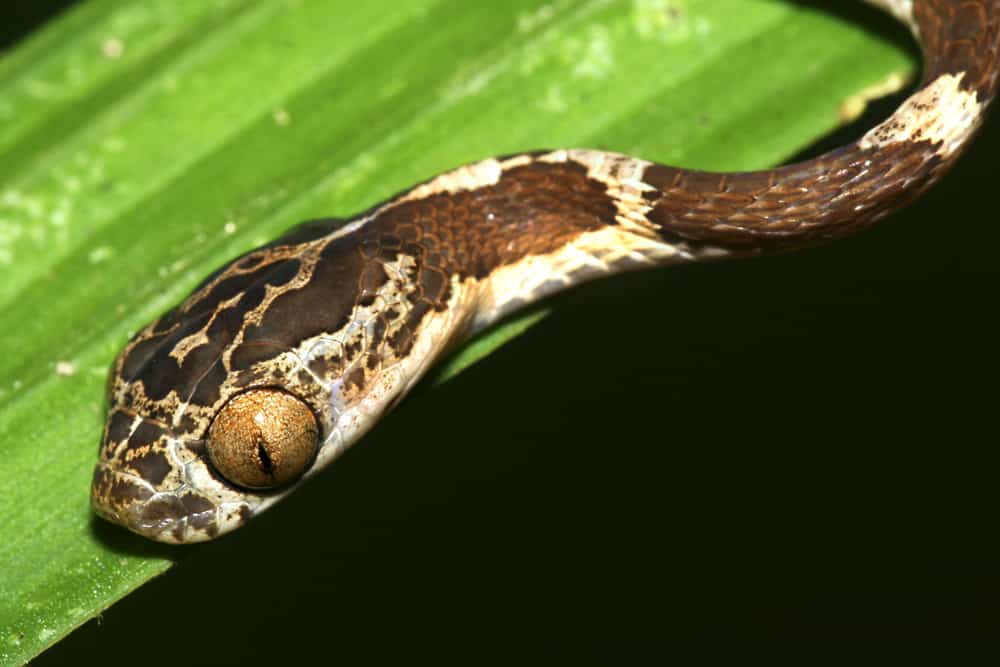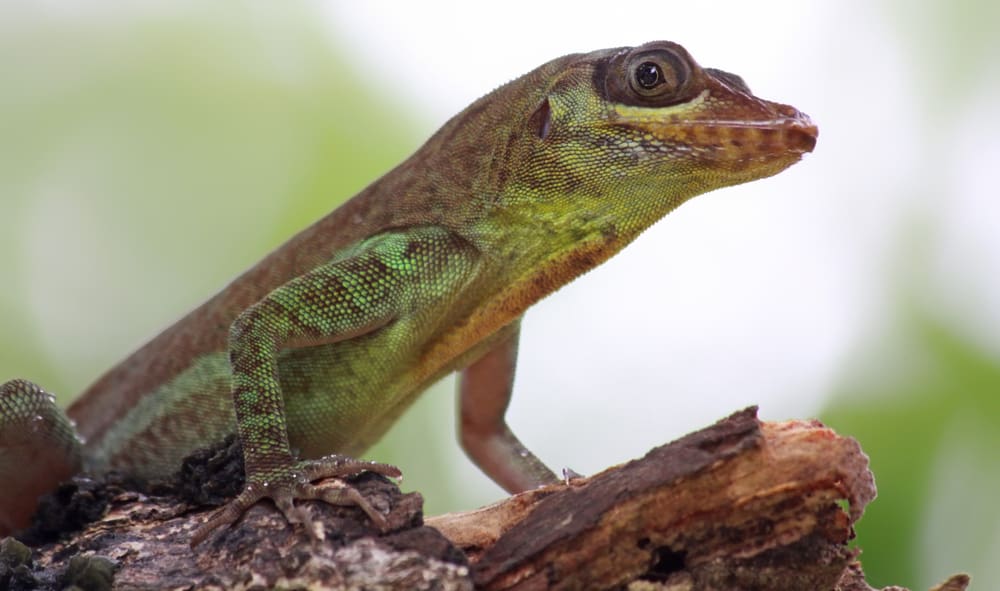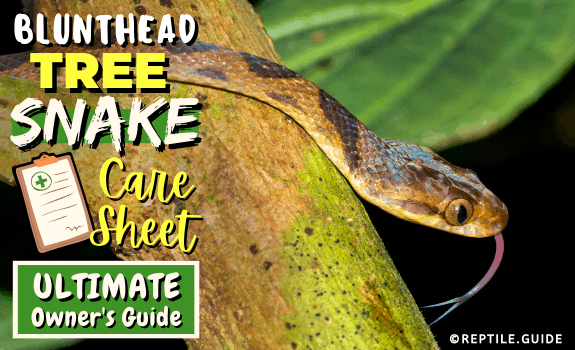The blunt-headed tree snake (Imantodes cenchoa) is a beautiful oddity that has begun to show up in the pet trade in recent years.

These beautiful though somewhat unusual snakes aren’t the best pets on the market. Their lizard-based diet and strange habits are better suited to an experienced handler.
Join us as we take a look at the blunt-headed tree snake, both in the wild and in captivity.
In This Article
An Overview of the Blunt Headed Tree Snake
- These back-fanged beauties are mildly venomous, and they’re a docile species.
- Blunt-headed tree snakes are tree-dwelling snakes from Central and Southern America. They’re also found in Mexico.
- Blunt-headed tree snakes have a somewhat unusual diet when compared to most pet snakes. They eat mainly frogs and lizards.
- If you’re looking for your first arboreal snake, this isn’t the ideal species— blunthead vine snakes are difficult to keep alive in the hands of a new keeper.
Background Information about the Blunt-Headed Tree Snake
Blunthead tree snakes go by several different names.
These include blunt-headed snake, blunt-headed vine snake, blunthead vine snake, fiddlestring snake, and mapepire corde violon.
Let’s look at some of the characteristics typical of blunthead vine snakes in the wild.
Appearance and Size
As their name suggests, blunt-headed vine snakes have short, stubby heads that end in a dull, blunted point. They also have very thin necks.
Thanks to their nocturnal habits, blunt-headed tree snakes have large eyes. In fact, around a quarter of the snake’s head is dedicated to the eyes.
The snakes also have vertical pupils, which allow them to make the most of the available light.
Thanks to the fact that their eyes protrude from the sides of their heads, blunthead vine snakes can look downward and not just straight forward.
Like most arboreal snakes, these snakes tend to be long and slender.
More often than not, these snakes will stop growing at a length of 31 to 35 inches. Sometimes, a snake might reach lengths of up to 39 inches.
Blunthead tree snakes have a white belly and a light brown upper side. They also have dark brown blotches, which vary in amounts depending on the snake’s range.
The snakes may have anywhere between 29 and 56 patches depending on the region it comes from.
Distribution of Blunthead Tree Snakes
Although considered a threatened species, blunt-headed tree snakes have a large distribution covering much of Central and South America.
Blunthead tree snakes occur as far north as Eastern Mexico.
Central America has the largest percentage of recorded sightings.
The Habitat Blunthead Tree Snakes Inhabit
In the wild, the blunt-headed vine snake prefers forested areas. Thus, their preferred habitat is wet forests, rainforests, and other wet areas with many small trees.

Image credit: Eveline de Bruin (Pixabay)
As we mentioned earlier, this is a South American species, and it lives in large parts of the Amazon and cloud forests of western South America.
This is a highly arboreal species, and it rarely leaves the trees.
Adults of the species spend most of their time in the trees while smaller individuals frequent dense vegetation.
Becauses of this, farm workers often find them when working in the coffee fields.
Younger snakes inhabit any dense vegetation, and workers often find them in bundles of coffee tree leaves.
Because they are a nocturnal species, Bluntheaded Tree snakes prefer dense and shaded vegetation
Since the snakes aren’t too selective about their surroundings, they often move into secondary growth forests like the ones farmers fill with coffee trees.
Diet of a Blunt-Headed Tree Snake in the Wild
As we’ve mentioned earlier, blunt-headed tree snakes have a rather odd diet compared to most captive snakes.
Thanks to their very thin necks, they can only swallow prey of a certain size.
When you combine that with the snake’s nocturnal habits and arboreal habitat, they have limited prey options.
Scientists have found that these snakes tend to eat two main types of small arboreal lizards: the anole and the dwarf gecko.
Experts have observed changes in the feeding habits of blunt-headed tree snakes.
They sometimes come down to the forest floor, where they catch small lizards among the leaf litter.
When these snakes forage among the leaf litter, they’ll eat small lizards and frogs and sometimes large insects.
Is the Blunthead Tree Snake Venomous?
Blunthead tree snakes have rear fangs and lack potent venom (they’re nowhere near one of the most venomous snakes).
As with most snakes, blunt-headed tree snakes prefer flight to fighting and aren’t known to bite humans.
There are no recorded human fatalities involving blunt-headed tree snakes.
Blunthead Tree Snake as a Pet
As much about this species remains a mystery, only seasoned collectors should attempt to keep this species.
Their strange feeding habits, arboreal habits, and lack of a mating season (or continuous reproduction, for that matter) make them hard to keep and breed.
There have been some reports of keeping these snakes alive, but the lack of dedicated breeders means that most new snakes are imported from the wild.
Lifespan
There’s no definite lifespan for these snakes. Scientists believe that life expectancy varies depending on the region.
The best guess for the wild lifespan of these snakes is anywhere between six and ten years.
Few blunthead vine snakes in captivity have lived long enough to determine their captive lifespan.
Most pet blunt heads are young specimens imported from the wilds, and often become too stressed to adapt to their new surroundings.
Feeding in Captivity
In the wild, these snakes have diets that consist of young lizards and amphibians.
Some keepers believe that, if they manage to breed this species in captivity, it would probably accept rodents as part of its diet.
These snakes have large heads with rear fangs, which limits their prey choices. Studies done in the wild have shown very little evidence of Bluntheads eating rodents.
Since most captive blunthead vine snakes are caught in the wild, they’re used to a diet that includes lizards, amphibians, and large insects.
Any food sources you try feeding them in captivity should take this into account, as well as that their large heads lead to thinner necks.

Food sources worth trying include:
- Feeder anoles
- Feeder geckos
- Superworms
- Dubia roaches
Difficulty may occur in feeding captive snakes pre-killed prey. Offering live dubia roaches and superworms may give you an entry to larger pre-killed prey.
You might also want to try pinkies or fuzzies on the off chance that you have the perfect blunthead snake.
Finding a few snakes that are more willing to eat in captivity may lead to some breeding success.
Housing
When you set up an enclosure for your blunthead vine snakes, you must consider their natural habitat.
You want to buy an enclosure that has plenty of height because of the blunthead tree snake’s arboreal lifestyle.
Since it won’t be practical to grow a coffee tree or large bundles of vines inside the enclosure, you could consider adding reptile vines or a similar product.
As far as live plants go, Pothos are an excellent choice and grow well. Bromeliads are another excellent addition to the enclosure.
Since the snake is tree-dwelling, it would be a good idea to attach the food and water bowls to the side of the enclosure rather than having them on the floor.
Finally, the blunt-headed tree snake comes from wet habitats like rainforests, so it will probably benefit from the inclusion of a misting system in its enclosure.
Temperatures
It would be safe to assume that Blunthead tree snakes require a similar temperature gradient to other arboreal species from the South American rainforest.
Species like the Amazon Tree Boas do well when kept with a decent temperature gradient and a lower nighttime temperature.
We suggest trying the following temperature range:
- Cool end: 70-75°F
- Warm end: 85-89°F
- Nighttime temperature: 65-69°F
These snakes come from damp environments with high humidity, so you probably want to aim for relative humidity between 75 and 85.
Should I Expect Reptile Eggs From my Blunt-headed Tree Snake?
If you’re after the experience of hatching reptile eggs and breeding your snakes, you might want to look elsewhere.
We don’t know a lot about breeding these snakes in captivity, probably because no one has put much effort into breeding this snake species.
Observations From the Wild
In the wild, blunthead tree snakes time the breeding season to coincide with the long rainy seasons of their habitats.
Like most other snakes, the female snakes come down to the forest floor to lay their eggs.
Blunthead tree snakes break away from other snakes in that the breeding season doesn’t consist of a mating season and a season for egg-laying.
Female snakes are open to mating year-round, even if they only lay eggs in the rainy season.
Since this snake species lives in habitats with long wet seasons, you may think that the snake might practice continuous reproduction.That doesn’t seem to be the case, though.
Whether it’s programming from the species’ natural history or an increase in the amount of small arboreal lizards, these snakes have shunned continuous reproduction.
There is evidence, however, that the breeding season is longer in regions with longer wet seasons. Conversely, short wet seasons lead to fewer clutches per year.
On average, female blunthead tree snakes produce clutches of two to three eggs which typically hatch between March and August.
Perhaps, in the not too distant future, an enterprising breeder will learn how to mimic the rainy seasons accurately and start breeding blunthead tree snakes reliably.
Is it Legal to Keep Venomous Snakes like the Blunthead?
In most parts of the United States, it’s legal to keep venomous snakes like the blunthead.
You’d be wise to research the specific bylaws in your region, though, since some jurisdictions may require a license.
Other, stricter bylaws may limit the keeping of venomous snakes to professional institutions and university collections.
It’s all up to you to research the laws in your area.
Easier Tree-Dwelling Snakes to Keep
While most Arboreal snake species aren’t considered good for beginners, the Blunt-headed tree snakes have special difficulties.
The fact that almost all (if not all) specimens are collected from the wild, and the species has very specific dietary needs makes it even harder to keep.
We’ve had a look around and decided to suggest some of our favorite arboreal species, which are easier to keep.
- Spotted Pythons – These spectacular snakes are one of the smallest python species. They have no venom and are generally quite calm.
- Amazon Tree Boas – These smallish boas have the slender build of most arboreal species, with larger heads, and come in a shocking array of colors.
- Emerald Tree Boas – These snakes are significantly larger than Amazon tree boas, non-venomous, and rather aggressive. Not for the faint-hearted.
Spotted pythons are the ideal first snake when you’re transitioning from terrestrials to arboreals.
We hope you’ve enjoyed this article about Blunthead tree snakes.
If you truly wish to see this snake in a situation where it thrives, we suggest booking a trip to the rainforest or visiting one of the zoological gardens that keep them.
If you’ve enjoyed this article, check out our articles about other South American beauties, like the Brazilian Rainbow Boa.
Would you try keeping a blunt-headed tree snake? Let us know in the comments.
